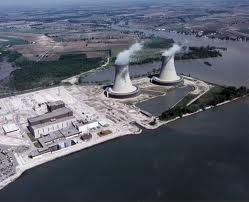I have blogged about many problems connected to the use of nuclear reactors to generate electricity. One of the issues that I don't think gets enough attention is the question of water use. Nuclear reactors take a huge amount of water to cool the reactor. In the last few years reactors have been shut down because the lake or ocean water being used for cooling is too warm. With global climate change warming water around the world, this problem will just get worse. There is also the danger of flooding at nuclear power plants because they are located near large bodies of water and weather is becoming more extreme due to global climate change increasing the danger of major storms. Another water related issue is the question of the effects of releasing hot water back into the ecosystem after it has been used to cool the reactor.
At the beginning of August, the city officials of Toledo, Ohio warned the citizens of Toledo not to drink the water from the municipal water system because of contamination from an cyabno-algae bloom in the lake. The cyano-algae that is blooming in the lake is releasing a toxin called microcystin LR that is harmful to human health. The symptoms of microcystin LR poisoning include headaches, fatigue and renal damage. Algae blooms are common in the tropics but rare in temperate areas such as Ohio.
The Beyond Nuclear movement at Lake Erie has been complaining for years that algae blooms on the Lake are being caused by the hot water being released from the cooling system of the number 2 reactor at the Enrico Fermi nuclear power plant. The number 2 reactor is a General Electric boiling water reactor that is the same design as two of the reactors that melted down at Fukushima. Given the abnormally cold weather this year in the U.S. Midwest, the Beyond Nuclear protestors claim that the only possible cause of heating in the southern part of Lake Erie is the reactor.
The phosphorus from fertilizers being used in agriculture in around the southern part of Lake Erie has been pouring into the lake and providing nutrients for the algae blooms. Such blooms were a problem in the 1970s and 1980s before changes in farming methods reduced the occurrence of algae blooms. Now the blooms are back and are being blamed on there was increased sediment from heavy rains running into the lake in the spring of 2011 and an increase dissolved reactive phosphorus in the water running into Lake Erie. The nuclear power plant is causing a ten to fifteen degrees Fahrenheit increase in the temperature of the southern part of the lake. Together, these factors are contributing to the reappearance of algae blooms. Scientists also believe that the presence of low levels of radioactive isotopes in the reactor wastewater is causing explosive growth in the cyano-algae. Cyano-algae has a special affinity for phosphorus-32 from the reactor which may be causing mutations in the cyano-algae and promoting its growth at the expense of harmless algae that does not release toxins.
These toxic algae blooms are another harmful result of the use of nuclear reactors to generate electricity. The population of a large U.S. city is being threatened and I am sure that the company running the Fermi nuclear power plant will not be asked to pay for the damage from the cyano-algae bloom. Instead, once again, the tax payers will be expect to foot the bill.
Enrico Fermi Nuclear Power Plant:
